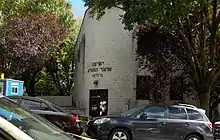Grodno Yeshiva
Yeshiva Shaar HaTorah – Grodna, often referred to as the Grodna Yeshiva or simply as Grodna, was a Orthodox Jewish yeshiva in the Belarusian city of Grodno, then under Russian rule. Founded during World War I, Rabbi Shimon Shkop became rosh yeshiva in 1920.
| Yeshiva Shaar HaTorah ישיבה שער התורה | |
|---|---|
| Location | |
Belarus | |
| Information | |
| Religious affiliation(s) | Orthodox Judaism |
| Established | 1914 or 1916 |
| Closed | 1939 |
| Dean | Rabbi Shimon Shkop |
| Enrollment | 200+ students |
History
Early years
The yeshiva was founded in either 1914[1] or 1916, formed with the enrollment of yeshiva students who were displaced from the ongoing World War I.[2] Rabbi Refael Alter Shmuelevitz (father of Rabbi Chaim Shmuelevitz), was appointed as rosh yeshiva,[3] and Rabbi Yosef Leib Nenedik was the yeshiva's first mashgiach ruchani.
Rabbi Shimon Shkop
In 1920, at the urging of Rabbi Yosef Shlomo Kahaneman, as well as the encouragement of Rabbi Yisrael Meir Kagan (the Chofetz Chaim) and Rabbi Chaim Ozer Grodzenski, Rabbi Shimon Shkop became rosh yeshiva. Rabbi Shlomo Harkavy became mashgiach around that time too; as part of his job, he was supposed to give students mussar (rebuke) when they did something wrong. However, as opposed to directly approaching a student and rebuking him for a specific act, he would simply talk about that type of wrongdoing with another person while in earshot of the student.[4] A son-in-law of Rabbi Shkop, Rabbi Shraga Feivel Hindis, assisted his father-in-law in running the yeshiva.[5]
The hasmadah (diligence in Torah study) in the yeshiva was well known, with the average student studying fifteen hours each day. The most diligent students were called the "Lions of Grodno" or in Yiddish, the "Ariyos fun Grodno"; they were capable of learning for eighteen hours a day. Among the "lions" were Moshe Zaretsky and Yisrael Zev Gustman, future rosh yeshiva in Ramailes. The two both used stay in the beis medrash (Torah study hall) for months, immersed in Torah learning. The yeshiva schedule was extremely rigorous with shacharis at seven o'clock in the morning and night seder (learning session) finishing at 1 AM.[6]
The yeshiva was divided into two schools: the yeshiva ketana for younger students and the yeshiva gedolah for older ones. Rabbi Chaim Shmuelevitz gave a shiur (class) in the yeshiva ketana. The rosh yeshiva, Rabbi Shkop gave shiur for the yeshiva gedolah. Rabbi Shkop's shiur would sometimes last over two hours long.
Under his leadership, the yeshiva grew to over 200 students.[2]
Disbandment and legacy

At the Soviet Occupation of Poland in 1939, the yeshiva disbanded and fled to Vilnius. Rabbi Shkop however wasn't healthy enough for the journey, and remained in Grodno, where he passed away soon after.
The yeshiva was reestablished in Queens, New York and led by Rabbi Zelig Epstein, a grandson-in-law of Rabbi Shkop, under the same name, Yeshiva Shaar HaTorah.[1] Rabbi Yosef Shlomo Kahaneman opened another reestablishment of the yeshiva in Ashdod, Israel, as a branch of his Ponovezh Yeshiva.
Notable Alumni
- Rabbi Chaim Leib Shmuelevitz, rosh yeshiva of Mir
- Rabbi Yisrael Zev Gustman, rosh yeshiva of the Ramailes Yeshiva
- Rabbi Zeidel Epstein, rosh mesivta at RJJ and mashgiach at Torah Ohr
- Rabbi Shmuel Rozovsky, rosh yeshiva of the Ponovezh Yeshiva
- Rabbi Eliyahu Mishkovsky, (he) rosh yeshiva of Knesses Chizkiyahu
- Rabbi Tzvi Markovitz, (he) rabbi in Ramat Gan and rosh yeshiva of the Karlin-Stolin Yeshiva in Jerusalem
- Rabbi Naftali Wasserman, son of Rabbi Elchonon Wasserman
- Rabbi Zev Wein, Rabbi of Beth Hamedrosh Hagadol Kesser Maariv in Chicago; (father of Rabbi Berel Wein)
References
- Zakon, Rabbi Nachman (June 2003). The Jewish Experience: 2,000 Years: A Collection of Significant Events (Second ed.). Shaar Press. p. 166. ISBN 1-57819-496-2.
- Krohn, Rabbi Paysach (January 2007). Traveling with the Maggid. Brooklyn, NY: Mesorah Publications, Ltd. p. 203-207. ISBN 978-1-4226-0229-4.
- "Rabbi Shimon Shkop". Eilatgordinlevitan.com. Retrieved August 9, 2020.
- Page, David (January 2017). Rav Gustman (First ed.). Mesorah Publications, LTD. p. 53. ISBN 1-4226-1859-5.
R' Shlomo Harkavy, the Mashgiach of Grodno, gave...mussar in the Grodno style, by speaking not to...[the student] directly, but rather in front of him.
- "Letter by Rabbi Shraga Feivel Hindis – Son-in-law of Rabbi Shimon Shkop". Kedem-auctions.com. Kedem Auction House. Retrieved August 16, 2020.
Rabbi Shraga Feivel Hindis (1878-1936), eminent son-in-law of Rabbi Shimon Shkop as well as his assistant in managing the yeshiva in Grodno.
- Page, David (January 2017). Rav Gustman (First ed.). Mesorah Publications, LTD. pp. 44–45. ISBN 1-4226-1859-5.
.jpg.webp)